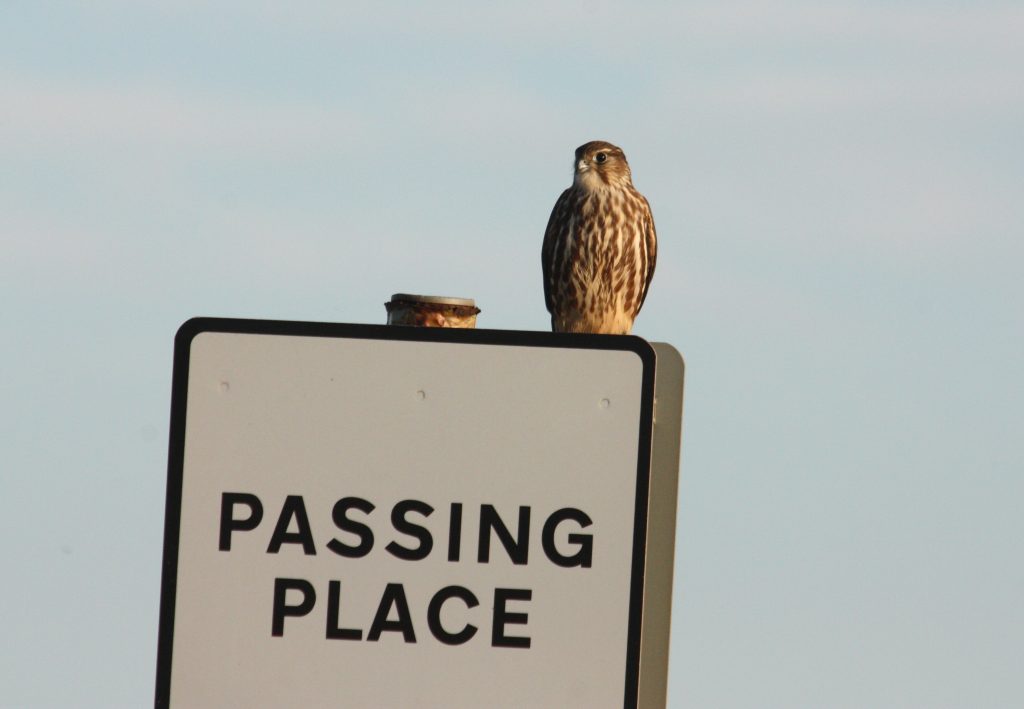On Thursday 14th November 2019 the usual room in the Dark Island Hotel used for Curracag talks was filled to capacity for Andrew Stevenson’s talk on our local raptors, a talk organised by Martyn Jamieson for Curracag, but open to anyone interested.
Andrew started by telling us modestly that his talk was based on the work of the Uist Raptor Study Group, one of 13 raptor study groups which cover Scotland, and of which he has been an active member for a number of years. Even for the most dedicated groups, keeping track of a range of birds with a small membership in some of the challenging terrain we have, especially on the east side of Uist, is very difficult.
He described briefly the range of habitats available to raptors: the extensive hill and moorland, loch systems, machair, offshore islands and cliff, providing a wide range of food sources from various sizes of birds, mammals and carrion. Of the smaller mammals, woodmice, rats and rabbits are present in most of the islands, but field voles are not known in Barra or some of the offshore islands, and though hares were introduced to North Uist in the last century they have not survived, so the range is limited. Likewise, the range of predators is more limited than on the mainland, as we have no foxes or pine martens.
Other factors that affect some of the birds (and their prey) are weather; wet and windy springs and summer can affect nesting birds; and muirburn, when carried out outside the legally permitted season and not controlled. Human interference is limited.
Andrew then took us through a list of our resident raptors, with comments on each.
Golden Eagle, for which there are about 25 ranges in Uist, taking as prey birds such as red grouse, ducks, sometimes fulmars, geese, and also rats and rabbits; one pair seem to specialise in taking gannets. Recently some eaglets have been found dead or dying from an unknown cause, but not a lack of food sources. Our golden eagles are slightly different from the mainland population; there seems to be very little if any exchange across the Minch.
White-tailed Eagle, which now has 11 ranges in Uist, the result of expansion since their re-introduction to Scotland in the 1970s and 1980s. They take wildfowl, grouse, and herons, and even hedgehog and octopus have been known to feature in the diet!
Uist supports between 40 and 50 breeding female Hen Harriers, a big improvement on the 10 to 15 pairs known in the 1980s, nesting on moorland and foraging over considerable distances, sometimes as much as 11 kilometres. They are not present in Barra as there are no field voles, one of the main prey items. They have recently colonised Lewis despite the absence of voles, feeding mainly on small birds.
Similarly, Short-eared Owls only breed in Uist; between about 60 and 90 pairs, with a long breeding season, the earliest chicks fledging in mid May while some appear in August. Short-eared owl populations are declining internationally; ours fluctuate although the Uist vole populations don’t seem to crash as they do in other places.
Long-eared Owls breed rarely in North and South Uist, possibly about 10 pairs, but are difficult to find and study as they are nocturnal owls, unlike the short-eared owls which fly during the day and are often seen from the road.
There may be about 95 to 100 pairs of Buzzards, which are mainly on the west side, and will be familiar to most.
Peregrines are limited: in 2002 there were 19 ranges, but now there seem to be fewer, paralleling a decline on the mainland. Prey: waders, seabirds and rock doves are not in short supply.
There are probably 20 to 30 pairs of Merlin, taking passerines and small waders.
And a similar number of Kestrel, living mainly on the east side on Uist. These too are declining nationally.
Sparrowhawk is a recent colonist, arriving about 2001. 10 pairs take advantage of the conifer plantations that are a comparatively recent habitat in Uist, and even sometimes gardens.
Andrew bestowed honorary raptor status on the Raven, which is widespread, 70 to 90 pairs frequenting quarries, trees, disused buildings, mainly in remote areas. A large non-breeding population use different roost sites. Pellet analysis in 1997 showed that their food was mainly rabbit, birds and small mammals.
Though large raptors may take smaller ones: eagles will eat everything; buzzards take short eared owl and hen harrier chicks, but smaller raptors don’t necessarily avoid the larger ones, being, apparently, more concerned about their own food availability.
Andrew also mentioned species that visit occasionally such as snowy owls and honey buzzards.
